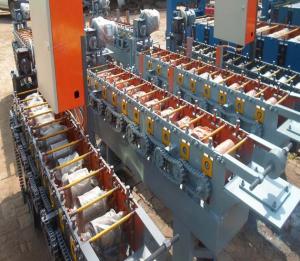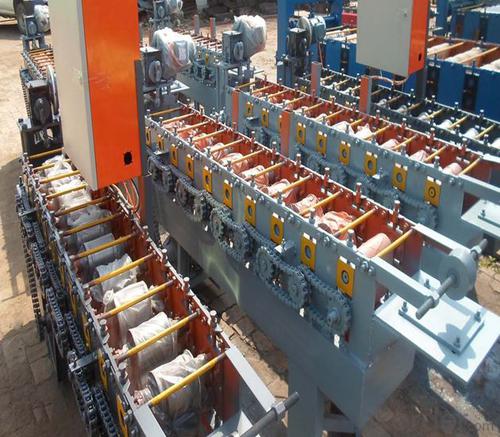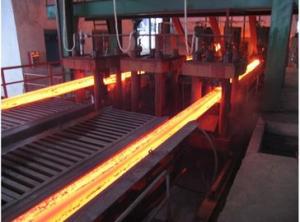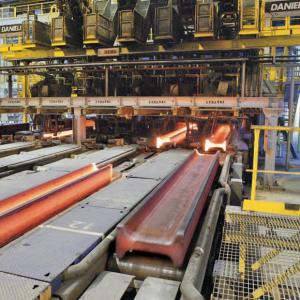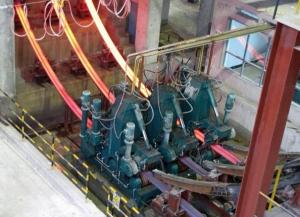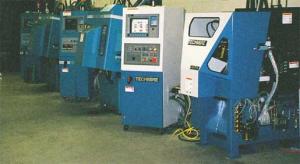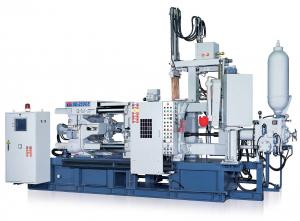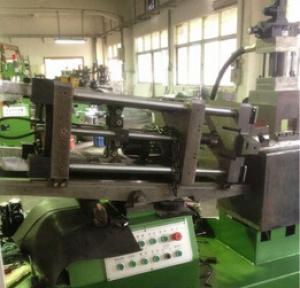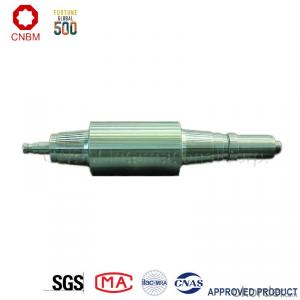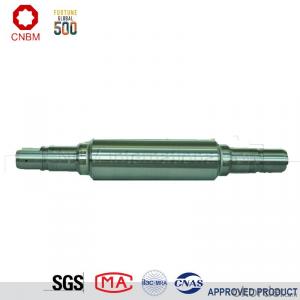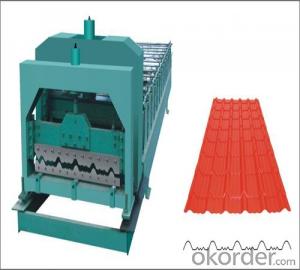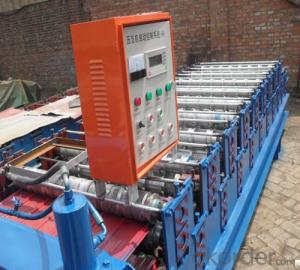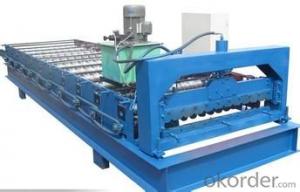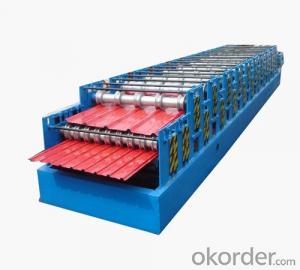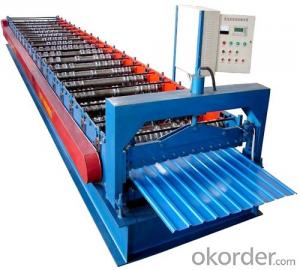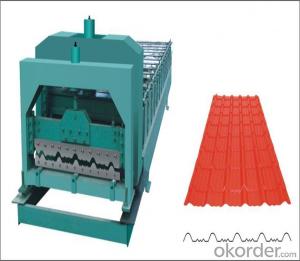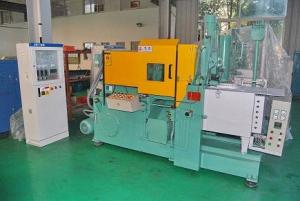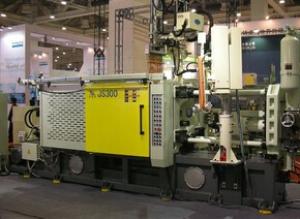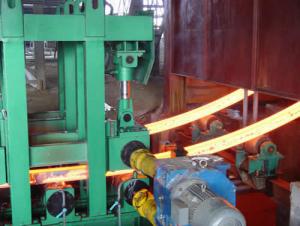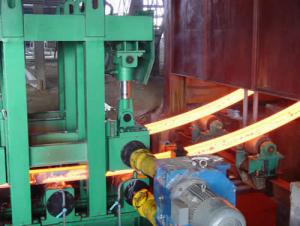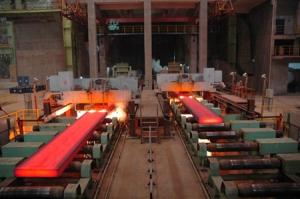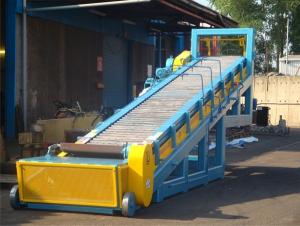Steel Tile Roll Forming Machine in Good Shape
- Loading Port:
- Tianjin
- Payment Terms:
- TT OR LC
- Min Order Qty:
- 1 pc
- Supply Capability:
- 100 pc/month
OKorder Service Pledge
OKorder Financial Service
You Might Also Like
STEEL TILE ROLL FORMING MACHINE
1.Structure of steel tile roll forming machine:
Steel tile roll forming machine consists of feeding, forming, after forming cutting production of color plate smooth appearance beautiful appearances, uniform lacquer veins, high strength, durable, widely used in industrial and civil buildings, such as workshop, warehouse, gymnasium, exhibition halls, theaters and other surface and wall.
2.Main Features of the steel tile roll forming machine:
The tile roll forming machine has the advantages of good corrosion resistance, colorful, beautiful appearance, convenient processing molding and the advantages of the the original strength of the steel plate and the cost is low.
First generation and second generation "automatic moulding color tile equipment" adopt "swinging cylinder driving sliding table", "swinging cylinder" belong to "moulded caigang watts equipment" is "extremely fragile" in accessories, if the forming speed is too fast, cause a large sliding table shock, buffer vibration easily, cause the tiles have crack, is the first and the second generation "stubborn" in the color tile equipment. So the fastest forming up to 6 pieces per minute.
3.Steel tile roll forming machine Images
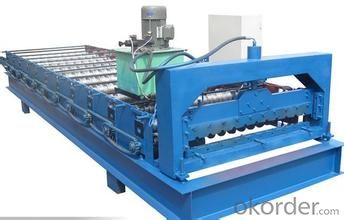
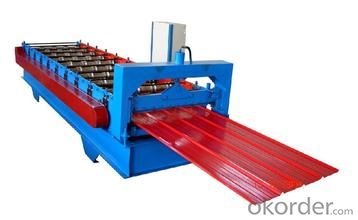
4.Steel tile roll forming machine Specification
Steel tile roll forming machine has a lot of parameters to set, by using the text screen or touch screen setting. Parameter setting, which has two kinds of equipment parameters and user setting.
Equipment parameters: single pulse length, impulse, molding, molding time, cutter and so on.
User parameters: the number, length, pitch, the first section, small section, section number, preloading and so on.
Main moter power 5.5KW
Hydraulic station power 4KW
Hydraulic oil pump CB-E310
Sprocket P-25.4
Roller station 13
Yield strength 32MPa
Diameter of principal axis 90MM
Material of roller 45#steel hard chrome plating
Processing speed 10-15m/min
Thickness 0.3-1.2 mm
Installation dimension about(L*W*H) 7.5*1.3*1.5M
Total weight 4.2T
Equipment parts includes:roll forming system, hydraulic system, PLC frequency conversion control system, counter, cutting system,decoiler .
5.FAQ
We have organized several common questions for our clients,may help you sincerely:
1. What’s your machine installation & commissioning, training:
1or2 technicians will be dispatched to Buyer’s plant for installation & commissioning. Work period: in 5 days. The expense of round trip tickets, accommodation, safety and interpretation shall be covered by Buyer, additional pay allowance to the technicians.
2. Can you make machine according to my design?
Yes, we have experienced technical team to work out the suitable design for you and confirm with you until you agree.
3. What is the warranty for our machine?
We have one year guarantee, and provide whole life's technical support.
4.Is the machine automatic?
Yes, it can be manual and automatic.
- Q: What are the considerations for gas removal and extraction in metal casting machinery?
- When it comes to gas removal and extraction in metal casting machinery, there are several important considerations that need to be taken into account. These considerations are crucial to ensure the quality of the final product and the safety of the workers involved in the casting process. 1. Ventilation and exhaust systems: Proper ventilation and exhaust systems are essential for removing gases generated during metal casting. These systems help to prevent the accumulation of harmful gases and ensure a safe working environment. It is important to design these systems in a way that effectively captures and removes gases from the casting area. 2. Gas detection and monitoring: Installing gas detection and monitoring systems is crucial to identify and measure the presence of gases in the casting environment. This helps to ensure that the gas levels remain within acceptable limits and enables prompt action to be taken if dangerous levels are detected. 3. Degassing agents and practices: Using appropriate degassing agents and practices can help to remove gases from the molten metal before it is poured into the mold. Degassing agents such as fluxes or vacuum degassing techniques can effectively eliminate gases, improving the casting quality and reducing the risk of defects. 4. Mold design and venting: Proper mold design and venting play a significant role in gas removal during the casting process. The mold should be designed to allow gases to escape easily without getting trapped in the final product. The inclusion of vents and channels in the mold can facilitate gas removal and prevent the formation of defects like porosity. 5. Process control and optimization: Maintaining optimal process parameters, such as temperature and pouring speed, can help to minimize gas entrapment during metal casting. Controlling these variables ensures that the molten metal flows smoothly and allows gases to escape more effectively. 6. Safety measures: Gas removal and extraction should always prioritize the safety of workers. The machinery should be equipped with safety features, such as proper shielding and protective barriers, to prevent exposure to harmful gases. Adequate training and personal protective equipment should also be provided to workers to minimize the risk of gas-related accidents. In conclusion, gas removal and extraction in metal casting machinery require careful consideration of factors such as ventilation, gas detection, degassing agents, mold design, process control, and safety measures. By addressing these considerations, manufacturers can ensure high-quality castings and a safe working environment for their employees.
- Q: What are the training requirements for operating metal casting machinery?
- The training needed to operate metal casting machinery can vary depending on the machinery and industry. However, there are general requirements that apply to most machinery. To begin with, operators of metal casting machinery must have a basic understanding of the principles and processes involved in metal casting. This includes knowledge of different casting methods like sand casting, investment casting, and die casting, as well as an understanding of the materials and alloys used. In addition, operators need to be trained in the safe and proper operation of the specific machinery they will be using. This includes learning how to set up and configure the machinery for different casting jobs, as well as how to use the controls and monitor the process. Safety training is also crucial for operators of metal casting machinery. This involves learning about potential hazards and risks associated with the machinery, as well as how to use personal protective equipment (PPE) and follow safety guidelines to prevent accidents and injuries. In some cases, operators may need specific certifications or licenses to operate certain types of metal casting machinery. This could involve completing a formal training program or obtaining certification from a recognized industry organization or regulatory body. Operators should also receive ongoing training and updates to stay up-to-date with new technologies, processes, and safety standards. This can be achieved through refresher courses, workshops, seminars, or by staying informed through industry publications and resources. Overall, the training requirements for operating metal casting machinery involve technical knowledge, practical skills, and safety awareness. By ensuring operators receive proper training, companies can minimize risks and ensure efficient and safe operation of metal casting machinery.
- Q: What are the different types of binders used in sand casting with metal casting machinery?
- There are several types of binders that can be used in sand casting with metal casting machinery. The choice of binder depends on various factors such as the type of metal being cast, the desired casting quality, and the specific requirements of the casting process. One commonly used binder is clay, which is mixed with the sand to provide strength and cohesiveness to the mold. Clay binders are easy to use and provide good dimensional accuracy to the castings. Another type of binder is sodium silicate, also known as water glass. Sodium silicate binders offer good strength and good refractoriness, making them suitable for casting high-temperature metals such as steel and iron. They are also cost-effective and widely available. Polymeric binders, such as resins, are also used in sand casting. These binders can be thermosetting or thermoplastic in nature. Thermosetting binders, such as phenolic resins, provide excellent strength and dimensional stability to the mold. Thermoplastic binders, on the other hand, can be easily removed from the mold after casting, making them suitable for complex shapes and intricate designs. In addition to these binders, there are also specialty binders available for specific applications. For example, for casting non-ferrous metals like aluminum, magnesium, or brass, specialty binders like ethyl silicate or zircon binders may be used. These binders offer better resistance to the high temperatures generated during the casting process. Overall, the choice of binder in sand casting with metal casting machinery depends on the specific requirements of the casting process, the type of metal being cast, and the desired properties of the final casting. Each binder has its own advantages and limitations, and it is important to select the appropriate binder to ensure the quality and success of the casting process.
- Q: What are the different types of cores used in sand casting with metal casting machinery?
- The different types of cores used in sand casting with metal casting machinery include green sand cores, dry sand cores, shell cores, and cold box cores.
- Q: What are the different types of finishing processes used with metal casting machinery?
- Metal casting machinery commonly utilizes various finishing processes to enhance the surface quality, dimensional accuracy, and overall appearance of cast metal parts. Among the frequently employed finishing processes are: 1. Grinding: By employing an abrasive wheel or belt, grinding eradicates excess material from the metal part's surface. This process aims to eliminate rough edges and imperfections. 2. Sanding: Similar to grinding, sanding employs a finer abrasive material to achieve a smoother finish. It is often employed to eliminate any remaining rough spots or burrs on the part's surface. 3. Polishing: To attain a high-gloss finish, polishing employs either a polishing wheel or a polishing compound. This process enhances the part's aesthetic appeal, giving it a more professional appearance. 4. Deburring: Deburring aims to eliminate sharp edges or burrs that may have formed during the casting process. This process improves the part's safety and ensures it is free from potential hazards. 5. Shot blasting: Shot blasting involves propelling small metal particles at high speeds onto the metal part's surface. It eliminates scale, rust, or other contaminants, leaving the part clean and ready for subsequent finishing processes. 6. Painting or coating: This process entails applying a layer of paint or protective coating onto the metal part's surface. It enhances the part's appearance and protects it from corrosion or other forms of damage. These examples represent only a few of the numerous finishing processes available for metal casting machinery. The selection of which process to employ depends on factors such as the desired finish, the type of metal used, and the specific requirements of the part at hand.
- Q: How does metal casting machinery handle the removal of cores from the mold?
- Metal casting machinery handles the removal of cores from the mold through a process called core knockout. This involves applying force or vibration to the mold to dislodge and remove the core, allowing the cavity to be filled with molten metal.
- Q: How can defects be prevented or minimized in die casting with metal casting machinery?
- Defects in die casting can be prevented or minimized by implementing several measures. First and foremost, maintaining proper control over the metal temperature is crucial, as it helps to reduce porosity and improve the flow of the molten metal. Additionally, using high-quality die lubricants and ensuring their proper application can help prevent defects such as sticking and cracking. Proper design and maintenance of the die casting tooling, including regular cleaning and inspection, can also contribute to minimizing defects. Finally, employing appropriate process parameters, such as injection speed, pressure, and cooling time, along with rigorous quality control and inspection techniques, can further help in preventing or minimizing defects in die casting.
- Q: How is the casting repaired if defects are found in metal casting machinery?
- If defects are found in metal casting machinery, the casting is repaired by identifying the specific defect and implementing appropriate remedial measures. This may involve using techniques such as welding, grinding, or re-machining to correct any imperfections or inconsistencies in the casting. Additionally, quality control measures are often implemented to identify and prevent future defects in the casting process.
- Q: How is the casting inspected for dimensional accuracy in metal casting machinery?
- In metal casting machinery, the casting is inspected for dimensional accuracy through various methods and techniques. One of the primary methods used is dimensional inspection, which involves measuring the key dimensions of the casting using precision tools such as calipers, micrometers, or coordinate measuring machines (CMM). Before the casting process begins, the design specifications and tolerances are set, which serve as a reference for the inspection process. Once the casting is complete, it is removed from the mold and allowed to cool down. After cooling, the casting is cleaned and any excess material or debris is removed. The dimensional inspection starts by selecting critical areas or features of the casting that are crucial for accurate functioning or proper fitment. These areas could include holes, slots, or mating surfaces. The chosen features are then measured using the appropriate measuring instruments. For simple and small castings, handheld measuring tools like calipers or micrometers are commonly used. These tools provide a quick and accurate measurement of dimensional attributes such as length, width, height, and diameters. In cases where more complex and intricate castings are involved, a coordinate measuring machine (CMM) is employed. A CMM is a highly advanced piece of equipment that uses a probe to measure the casting's dimensions in three-dimensional space, capturing data points that can be analyzed for dimensional accuracy. The CMM can measure complex shapes, angles, and curves, allowing for a comprehensive inspection of the casting. Apart from dimensional inspection, visual inspection is also conducted to identify any surface defects, such as cracks, porosity, or incomplete filling of the mold. This inspection is usually done visually by trained inspectors who carefully examine the surface of the casting for any irregularities. Overall, the inspection process for dimensional accuracy in metal casting machinery relies on a combination of precision measuring tools, advanced equipment like CMMs, and visual inspection techniques. These methods ensure that the casting meets the required specifications and tolerances, ultimately ensuring the quality and functionality of the final product.
- Q: What are the different types of surface treatments applied to castings produced by metal casting machinery?
- There are several different types of surface treatments that can be applied to castings produced by metal casting machinery. These treatments are designed to improve the overall appearance, functionality, and durability of the castings. One common type of surface treatment is called polishing. This involves the use of abrasive materials to remove any rough or uneven surfaces on the casting, resulting in a smooth and shiny finish. Polishing is often used to enhance the aesthetic appeal of castings and make them more visually appealing. Another type of surface treatment is called painting or coating. This involves applying a layer of paint or coating material to the surface of the casting. The paint or coating can provide protection against corrosion, improve the casting's resistance to wear and tear, and enhance its overall durability. Different types of paints or coatings can be used depending on the specific requirements of the casting and the intended application. In addition to polishing and painting, there are other surface treatments that can be applied to castings. One such treatment is called shot blasting. This involves propelling small metal or abrasive particles at high speeds onto the surface of the casting. The impact of the particles helps to remove any impurities, scale, or oxide layers on the surface, resulting in a cleaner and more uniform appearance. Another surface treatment option is called plating or electroplating. This involves depositing a thin layer of metal onto the surface of the casting using an electrochemical process. Plating can improve the casting's corrosion resistance, enhance its aesthetic appeal, and provide a protective barrier against environmental factors. Furthermore, there are specialized surface treatments available for specific applications. For instance, castings used in high-temperature environments may undergo heat treatment, which involves subjecting the casting to controlled heating and cooling cycles to improve its mechanical properties and resistance to thermal stress. Overall, the choice of surface treatment for castings produced by metal casting machinery depends on factors such as the desired appearance, functionality, and intended application of the castings. By selecting the appropriate surface treatment, manufacturers can ensure that their castings meet the required standards and provide optimal performance in various industries.
Send your message to us
Steel Tile Roll Forming Machine in Good Shape
- Loading Port:
- Tianjin
- Payment Terms:
- TT OR LC
- Min Order Qty:
- 1 pc
- Supply Capability:
- 100 pc/month
OKorder Service Pledge
OKorder Financial Service
Similar products
Hot products
Hot Searches
